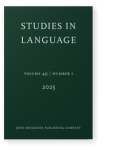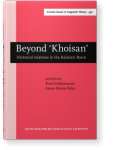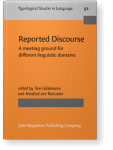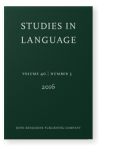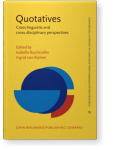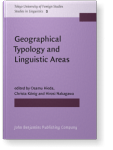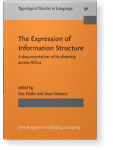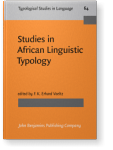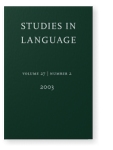Tom Güldemann
List of John Benjamins publications for which Tom Güldemann plays a role.
Journal
Titles
Beyond ‘Khoisan’: Historical relations in the Kalahari Basin
Edited by Tom Güldemann and Anne-Maria Fehn
[Current Issues in Linguistic Theory, 330] 2014. xii, 331 pp.
Subjects Historical linguistics | Other African languages | Theoretical linguistics
Reported Discourse: A meeting ground for different linguistic domains
Edited by Tom Güldemann and Manfred von Roncador
[Typological Studies in Language, 52] 2002. xii, 425 pp.
Subjects Discourse studies | Pragmatics | Typology
2016 Maximal backgrounding = focus without (necessary) focus encoding Studies in Language 40:3, pp. 551–590 | Article
Based on data from a range of geographically and genealogically diverse African languages this article describes a little recognized strategy for expressing focus. It is based on marking all material of an utterance as background except for the single focus constituent. This kind of “maximal… read more
2014 ‘Khoisan’ sibling terminologies in historical perspective: A combined anthropological, linguistic and phylogenetic comparative approach Beyond ‘Khoisan’: Historical relations in the Kalahari Basin, Güldemann, Tom and Anne-Maria Fehn (eds.), pp. 69–102 | Article
This paper combines regional anthropological comparison, historical linguistics and phylogenetic comparative methodology (PCM) concerning the analysis of sibling terminology in order to address the historical relationships between the languages of the three South African Khoisan families, Kx’a, Tuu… read more
2014 The Lower Nossob varieties of Tuu: !Ui, Taa or neither? Beyond ‘Khoisan’: Historical relations in the Kalahari Basin, Güldemann, Tom and Anne-Maria Fehn (eds.), pp. 257–282 | Article
North of the confluence of the Nossob, Auob, and Molopo Rivers in the Kalahari, several speech varieties of San groups have been attested, if only poorly, by linguistic data, notably ǀ’Auni and (Ku)ǀHaasi. Their relationship to the Tuu family (earlier referred to as ‘Southern Khoisan’) and their… read more
2014 ‘Khoisan’ linguistic classification today Beyond ‘Khoisan’: Historical relations in the Kalahari Basin, Güldemann, Tom and Anne-Maria Fehn (eds.), pp. 1–40 | Article
Proposed by Greenberg (1950, 1963) as a language family, the currently available evidence indicates that ‘Khoisan’ in a linguistic sense can be viewed, at best, as a negative entity. It comprises a diverse range of languages in southern and eastern Africa which share the typological feature of… read more
2012 Thetic speaker-instantiating quotative indexes as a cross-linguistic type Quotatives: Cross-linguistic and cross-disciplinary perspectives, Buchstaller, Isabelle and Ingrid van Alphen (eds.), pp. 117–142 | Article
Quotative indexes often do not simply encode a speech event but turn out to be grammatical constructions with the dual function of referring to a state of affairs and of orienting the audience to the presence of reported discourse. A still poorly-analyzed quotative strategy without overt reference… read more
2011 Proto-Bantu and Proto-Niger-Congo: Macro-areal Typology and Linguistic Reconstruction Geographical Typology and Linguistic Areas: With special reference to Africa, Hieda, Osamu, Christa König and Hiroshi Nakagawa (eds.), pp. 109–141 | Article
2010 The relation between focus and theticity in the Tuu family The Expression of Information Structure: A documentation of its diversity across Africa, Fiedler, Ines and Anne Schwarz (eds.), pp. 69–94 | Article
The paper presents first results of the documentation of Tuu languages regarding information structure, based on the analysis of coherent texts, partly supplemented by elicitated utterances. Unmarked clauses display a fairly strict verb-medial structure; the clause-initial subject can be… read more
2006 Complex predicates based on generic auxiliaries as an areal feature in Northeast Africa Studies in African Linguistic Typology, Voeltz, F.K. Erhard (ed.), pp. 131–154 | Article
2004 Reconstruction through ‘de-construction’: The marking of person, gender, and number in the Khoe family and Kwadi Diachronica 21:2, pp. 251–306 | Article
Kwadi is a virtually unknown and probably extinct click language of southwestern Angola. It has thus far not been assigned conclusively to any genealogical language group in Africa. Apart from being subsumed under the non-genealogical label ‘Khoisan’, the only concrete hypothesis has been to… read more
2003 Present progressive vis-à-vis predication focus in Bantu: A verbal category between semantics and pragmatics Studies in Language 27:2, pp. 323–360 | Article
Predication focus — a category where the predicate or a part thereof constitutes (or is part of) the sentence focus — is frequently encoded across the Bantu family by inflectional or morphosyntactic means. This phenomenon is associated with another observation which is rather unexpected at first… read more
2002 12. When ‘say’ is not say: The functional versatility of the Bantu quotative marker ti with special reference to Shona Reported Discourse: A meeting ground for different linguistic domains, Güldemann, Tom and Manfred von Roncador (eds.), pp. 253–287 | Chapter
2002 Preface Reported Discourse: A meeting ground for different linguistic domains, Güldemann, Tom and Manfred von Roncador (eds.), pp. vii–ix | Preface
2002 16. A comprehensive bibliography of reported discourse Reported Discourse: A meeting ground for different linguistic domains, Güldemann, Tom and Manfred von Roncador (eds.), pp. 363–415 | Chapter
